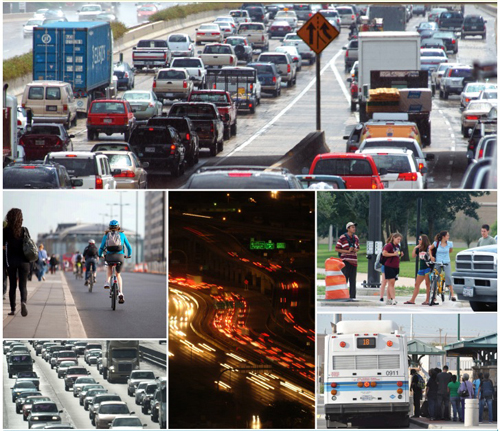TEXAS TRANSPORTATION INSTITUTE
Turning Congestion Data Into Knowledge (And the New Data Providing a More Accurate View)
 The 2012 Urban Mobility Report is the 3rd prepared in partnership with INRIX (1), a leading private sector provider of travel time information for travelers and shippers. The data behind the 2012 Urban Mobility Report are hundreds of speed data points on almost every mile of major road in urban America for almost every 15-minute period of the average day. For the congestion analyst, this means 600 million speeds on 875,000 thousand miles across the U.S. – an awesome amount of information. For the policy analyst and transportation planner, this means congestion problems can be described in detail and solutions can be targeted with much greater specificity and accuracy. Exhibit 2 shows historical national congestion trend measures.
The 2012 Urban Mobility Report is the 3rd prepared in partnership with INRIX (1), a leading private sector provider of travel time information for travelers and shippers. The data behind the 2012 Urban Mobility Report are hundreds of speed data points on almost every mile of major road in urban America for almost every 15-minute period of the average day. For the congestion analyst, this means 600 million speeds on 875,000 thousand miles across the U.S. – an awesome amount of information. For the policy analyst and transportation planner, this means congestion problems can be described in detail and solutions can be targeted with much greater specificity and accuracy. Exhibit 2 shows historical national congestion trend measures.
Key aspects of the 2012 UMR are summarized below.
- Speeds collected every 15-minutes from a variety of sources every day of the year on most major roads are used in the study. For more information about INRIX, go to www.inrix.com.
- The data for all 24 hours makes it possible to track congestion problems for the midday, overnight and weekend time periods.
- A measure of the variation in travel time from day-to-day is introduced. The Planning Time Index (PTI) is based on the idea that travelers would want to be on-time for an important trip 19 out of 20 times; so one would be late only one day per month (on-time for 19 out of 20 work days each month). A PTI value of 3.00 indicates that a traveler should allow 60 minutes to make an important trip that takes 20 minutes in uncongested traffic. In essence, the 19th worst commute is affected by crashes, weather, special events, and other causes of unreliable travel and can be improved by a range of transportation improvement strategies.
- Truck freight congestion is explored in more detail thanks to research funding from the National Center for Freight and Infrastructure Research and Education (CFIRE) at the University of Wisconsin (http://www.wistrans.org/cfire/).
- Additional carbon dioxide (CO2) greenhouse gas emissions due to congestion are included for the first time thanks to research funding from CFIRE and collaboration with researchers at the Energy Institute at the University of Wisconsin-Madison. The procedure is based on the Environmental Protection Agency’s Motor Vehicle Emission Simulator (MOVES) modeling procedure.
- Wasted fuel is estimated using the additional carbon dioxide greenhouse gas emissions due to congestion for each urban area. For the first time, this method allows for consideration of urban area climate in emissions and fuel consumption calculations.
- More information on these new measures and data can be found at: http://mobility.tamu.edu/resources/
…
Congestion Solutions – The Effects
The 2012 Urban Mobility Report database includes the effect of several widely implemented congestion solutions. These strategies provide faster and more reliable travel and make the most of the roads and public transportation systems that have been built. These solutions use a combination of information, technology, design changes, operating practices and construction programs to create value for travelers and shippers. There is a double benefit to efficient operations-travelers benefit from better conditions and the public sees that their tax dollars are being used wisely. The estimates described in the next few pages are a reflection of the benefits from these types of roadway operating strategies and public transportation systems.
Benefits of Public Transportation Service
Regular-route public transportation service on buses and trains provides a significant amount of peak-period travel in the most congested corridors and urban areas in the U.S. If public transportation service had been discontinued and the riders traveled in private vehicles in 2011, the 498 urban areas would have suffered an additional 865 million hours of delay and consumed 450 million more gallons of fuel (Exhibit 11). The value of the additional travel delay and fuel that would have been consumed if there were no public transportation service would be an additional $20.8 billion, a 15% increase over current congestion costs in the 498 urban areas.
There were approximately 56 billion passenger-miles of travel on public transportation systems in the 498 urban areas in 2011 (5). The benefits from public transportation vary by the amount of travel and the road congestion levels (Exhibit 11). More information on the effects for each urban area is included in Table 8 (pgs. 50-53).
View full report (PDF): 2012 Urban Mobility Report
About the Texas Transportation Institute
tti.tamu.edu
The Texas A&M Transportation Institute (TTI), a member of The Texas A&M University System, seeks solutions to the problems and challenges facing all modes of transportation. TTI works on over 600 research projects with over 200 sponsors annually at all levels of government and the private sector. TTI is recognized as one of the finest higher education-affiliated transportation research agencies in the nation and helps prepare students for transportation careers
Tags: INRIX, Texas A&M Transportation Institute, Texas Transportation Institute







 RSS Feed
RSS Feed